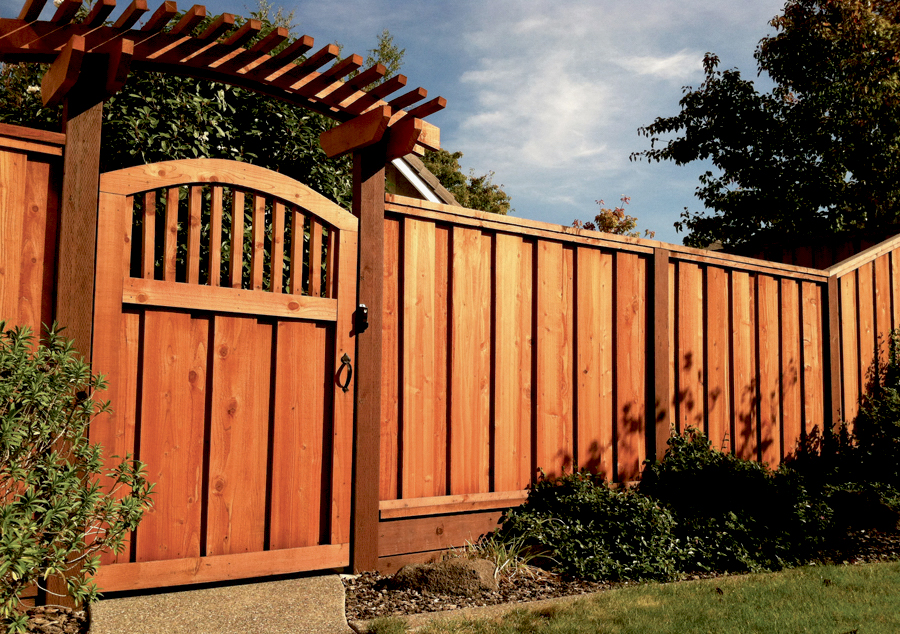For many folks in the Bay Area, the busiest room in the house is…the backyard. Grilling, playing and socializing outdoors puts neighbors in closer contact with each other, and while that can certainly lead to friendships, it can also cause friction. But you know what they say, good fences make good neighbors. This article covers why you might choose to invest in a high-quality fence and what options are best for your type of yard.
Keep in mind that many municipalities and homeowners’ associations have specific rules regarding the construction of new fences, so check with your local governing body before you start building.

A good fence will add security, privacy and value to your home. Photo: A & J Fencing ©2018
Fences for Pets
Dogs and humans take very different approaches to marking their property boundaries. The best way for your pet to enjoy the sights and smells of the outdoors without getting into trouble is by installing a good fence. As a pet owner, it’s your responsibility to prevent your dog from impeding on neighbors’ yards. Fences also keep pets safer, as they’re less likely to run into traffic or become lost. But the type of fencing you choose will depend upon your dog’s temperament.
Is your dog a barker? If your dog is agitated by every passing jogger, squirrel or fellow canine, you’ll need to select a fencing option that limits visibility. A wooden or vinyl privacy fence would be a good option.
Is your dog a jumper? If so, you’ll need to build your fence at the maximum permissible height. For most areas, that’s six feet high, although the limit will depend on your location. Placing shrubs in front of your fence will make it more difficult for your pets to escape your yard.
Is your dog a digger? Your best strategy is to install a fence that goes at least six inches deep or has a base layer made of a durable material like concrete. With diggers, it’s important to inspect wooden fences, as animals can escape through loose boards or injure themselves on splinters.
Fences for Security
If you’re concerned about trespassers on your property, you’ll want to choose a fence that’s strong and can be built to considerable height. Wrought iron or chain-link fencing is a popular choice for security fencing. While wrought iron is generally considered the more aesthetically pleasing choice, it’s also significantly more expensive than chain-link fencing. Note that both of these materials provide visibility, which may deter would-be intruders from loitering outside your property. No matter which option you choose, any fence will make it more difficult for others to reach your home.
Fences for Privacy
Homes are tightly packed in many Bay Area neighborhoods. Enjoying your backyard without the entire neighborhood watching is difficult without a good privacy fence.
Wooden tongue-and-groove fencing is a popular option for homeowners looking for more privacy. Such fences occlude visibility and can be constructed to the maximum permissible height. While affording maximum privacy, wood fences do need regular maintenance, including new coats of paint or sealant, board replacement and other touch-ups. Some homeowners go with vinyl privacy fences—they’re more expensive, but they offer the same seclusion with less regular maintenance. For the lowest-cost option, privacy slats can be added to chain-link fences.
When considering a privacy fence, make sure to account for the slope of your property in relationship to adjacent houses. If you’re upslope, you may be able to get away with constructing a shorter fence; if you’re downslope, neighbors may still be able to see into your yard even if you build the fence at the maximum permissible height. In the latter scenario, planting fast-growing trees may be a better option.
Fences and Fauna
If you live close to undeveloped land, you may be worried about coyotes finding your pets or deer rummaging through your garden. Both of these animals are great jumpers, so the typical six-foot fence will do little to deter their incursion onto your property. However, there are alterations you can make to your fence to make it harder for them to get in.
Fence extenders: These come in a variety of materials and styles. Choose extenders that branch out from the top of the fence at a 45-degree angle to prevent coyotes, deer and other wildlife from climbing into your yard.
Coyote rollers: These rotating tubes are installed at the top of the fence and prevent coyotes and other animals from grabbing onto the upper ledge. As an added benefit, they can also prevent more athletically gifted pets from escaping your yard.
Pool Fences
If your pool or spa doesn’t have a secure cover, California law dictates it must be enclosed by a fence. Pool fences must meet specific requirements that make it harder for children to gain access to the pool unsupervised. Homeowners may choose from a variety of materials—vinyl, wood, mesh—but the fences need to meet height requirements and have self-closing latches placed beyond the reach of small children. Regulations apply to in-ground and above-ground pools as well as hot tubs. Check with your local municipality to see if there are any additional regulations required for pools in your city.
Think of the Neighbors
Your neighbors should be part of the discussion when you’re building a fence. Ideally, you and your neighbors will hit upon a fencing solution that everyone likes and agree to split construction and maintenance costs. If you plan on going it alone, it’s still common courtesy to inform your neighbors of your plans. Make sure the fence is installed with the “inside” part (where the framing is visible) facing your property. In the end, you’ll find that good fences really do make good neighbors.
